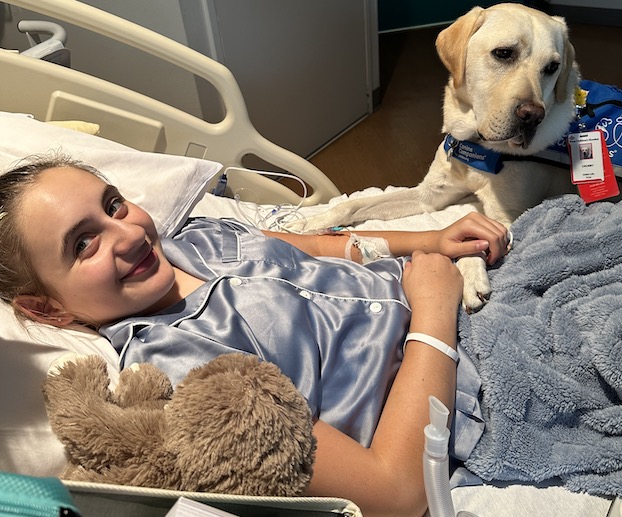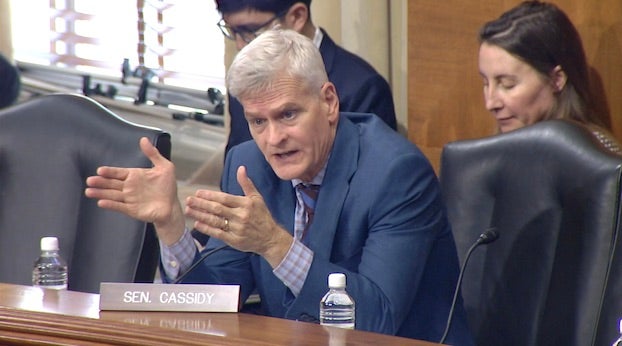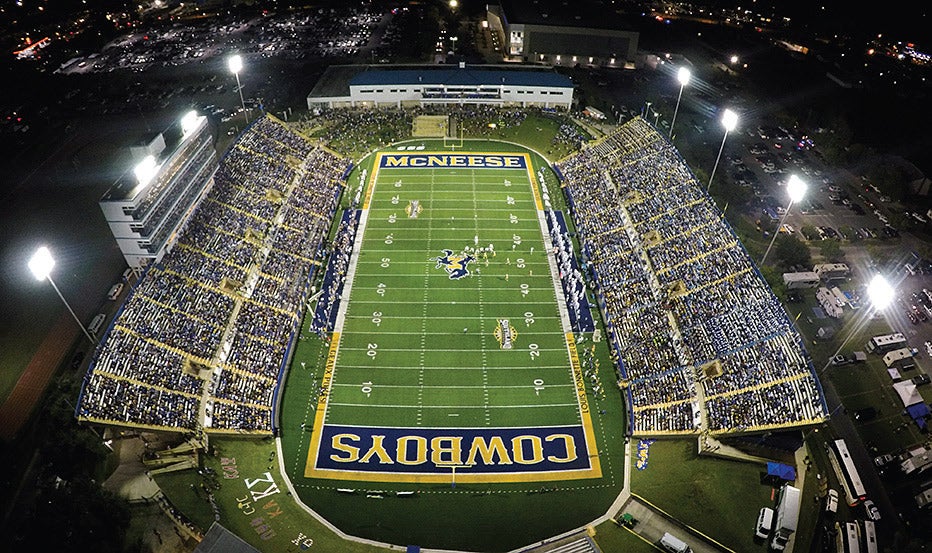‘Stay strong’: Scoliosis won’t stop 13-year-old Moss Bluff girl
Published 4:32 am Wednesday, July 9, 2025

- Crosby, a Canine Companion who visits patients at Texas Children’s Hospital, spends time with Braelyn Hebert after her spinal surgery. (Texas Children's Hospital / Special to the American Press)
Scoliosis will not stop 13-year-old Braelyn Hebert from doing what she loves: gymnastics.
Her love for gymnastics is simple. She loves to flip and she loves to do tricks. But when she was diagnosed with scoliosis last year, her passions were put on pause.
Flexibility has been one of Braelyn’s strengths, so she started dancing when she was 3, her mom, Samantha Hebert, recalled. After a group dance convention where Braelyn stayed in the back and did handstands, they decided gymnastics was the perfect sport for her.
Trending
“She did love dance, but she really loved the flipping aspect of it more, cartwheels and handstands,” Samantha said.
Braelyn became a competitive gymnast, where she coined the move, the “Braelyn Monkey Climb.” She climbs up a 25-foot rope upside down with her feet. While this move is a piece of cake for Braelyn, it is a task for everybody else, Samantha said.
“It was just so natural. She was like, ‘It’s easy, it’s not a big deal.’ There’s been many girls who have tried it at the gym,” Samantha remarked.
Diagnosis
During a routine scoliosis screening at her school in February 2024, a school nurse found that Braelyn could have scoliosis.
Things started to move fast. The school exam was on Feb. 20, 2024. The next day, Braelyn got her first X-ray.
Trending
The diagnosis came as a shock. She showed no signs of unalignment, experienced no pain and was not physically hindered. But X-rays showed that Braelyn had two 50-degree curves in her spine, one at the top and one at the bottom. Any spinal curve greater than 40 degrees is considered severe and requires surgery.
Because of the double curve, they would not have noticed the scoliosis without an exam, Samantha said.
“I was very nervous and anxious for the future and what was to come because we didn’t know a lot about scoliosis at the time,” Braelyn said. “We didn’t know if I was going to need surgery or if I was going to need bracing. It was just very chaotic and a lot. It was very overwhelming for sure at first because we had no idea.”
“Seeing her X-ray for the first time was just really, like, it was a shock because she was physically able to do so much. I guess it just didn’t make sense,” Samantha added.
On Feb. 23, Samantha called Texas Children’s, one of the largest pediatric hospitals in the United States.
Braelyn’s idiopathic scoliosis with a double major curve is uncommon and required a specialist, Samantha said. At Texas Children’s there is a team of five physicians who specialize in scoliosis and spinal deformity. There, she found Dr. Darrell Scott Hanson, who specializes in orthopedic surgery.
Surgery
As soon as Samantha learned about the Texas Children’s Scoliosis and Spinal Deformity Program, she got to work.
“I had initially gotten an appointment for April 1st, but I guess as a mom, I was just like, ‘That’s too far.’ It was over a month away. I just started calling Texas Children’s on that Friday. I’ve called several times, and I was like, ‘Is there anything sooner?’ ”
With persistence, she was quickly referred to Hanson. They saw him for the first time on March 19. On May 14, Braelyn had surgery.
She received a hybrid surgery. The bottom curve was fused, while the top curve received vertebral body tethering (VBT). VBT is a newer, less invasive surgery where the vertebrae are not fused. Instead, VBT acts as a growth modulation treatment. A flexible cord is attached to the spine to align it as the child grows. The alternative to spinal fusion allows patients to maintain most of their range of motion and flexibility, which was important to Samantha and Braelyn.
“We could have just had her fused, but she just turned 12. To fuse together 12 vertebrae in her spine just didn’t seem reasonable,” Samantha said.
Braelyn’s surgery lasted 11 hours. She was comfortable and confident before heading into surgery, but that didn’t mean she wasn’t nervous.
“I was very scared and very, very anxious because I didn’t know if I was going to be OK, but I also knew that I was going to be OK. I was overthinking it, and I was like, ‘Yeah, I’ll be fine, but also, ‘What if something happens?’ ”
Samantha was confident in the surgeons and Braelyn’s strength in the face of adversity.
“She’s been through more than a lot of adults,” Samantha said. “Nothing can stand in her way.”
Recovery
Three months after her surgery, Braelyn was back with her gymnastics team to regain her skills, “doing flips, climbing ropes and doing all the tricks,” and it felt good to come back home, she said.
“I was very happy. They were great. We were all just super happy to see that I was doing well and that I could still do a lot of my tricks. It was just amazing because they were all there for me.”
Her gym is filled with supportive peers and coaches who encouraged Braelyn during her recovery, Samantha said.
“When she just walked back in the gym, they were just like, ‘Hey!’ They celebrated her coming back and celebrated everything that she was able to accomplish and overcome.”
Braelyn started slow, with lots of tumbling and basics on the docket. But by September, she was able to complete her signature move, the Braylon Monkey Climb. And while she has not done gymnastics competitively since her surgery, she did make the cheer team at Moss Bluff Middle School.
Her capabilities post-op are due to the hybrid surgery she received, her mom said.
“Had we done the full fusion — which is kind of like the gold standard surgery that most people have and have had for many, many years — she probably wouldn’t have even been released to try out for cheer,” she explained. “With as much range of motion and flexibility that she would have lost, we just don’t know what that would have looked like.”
Through this journey, Braelyn has learned that she is stronger than she previously thought. She didn’t think she would be able to recover as well as she has, but she did. She didn’t think she was able to handle the stress as well as she had, but she did.
Her advice to other children facing a scoliosis diagnosis is for them to have faith in themselves.
“Stay strong,” she said. “Don’t be too afraid. Don’t overthink it. Probably, they’re still going to overthink it. Everyone overthinks. You are more capable of doing this than you might think. Just believe in yourself and trust that the hospital has you. They will do anything and everything they can to help you. The recovery will be rough, but it ends up the best. It’s worth it, for sure.
Samantha stressed the importance of scoliosis screenings for children. And in the case of scoliosis, she said to call Texas Children’s.
“They have so much experience and so much knowledge,” she said. “If you go to good doctors, you’re going to be in good hands.”





